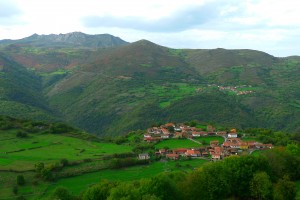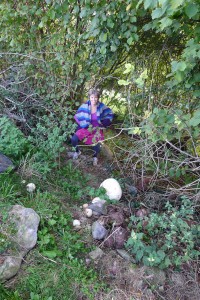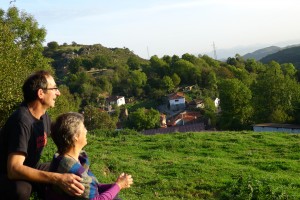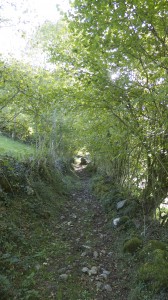Txema y Monica
We can’t leave the town of Belmonte without calling on this lovely couple, who run an organic smallholding in Albariza and who we’d first met at the Fiesta de la Huerta the week before where they had a stall. Here we stock up on a fresh assortment of beautiful organic veg, picking most of it ‘fresh off the vine’. On our walk through their fields and polytunnel we learn that Txema is in fact responsible for the whole cultivation aspect – whilst his wife prepares medicinal tinctures, soaps and various other organic products. With regards to the vegetables, they operate a radical pricing structure: go into the field, pick what you like, come back and weigh the bag. Everything is 2.20 Euros per kilo, no matter what you have chosen – aubergines, leeks, courgettes, apples, carrots, lettuce, tomatoes, onions, chard, you name it!
Txema tells us of his vision for the whole set-up: restoring the old farm house complete with Panera, creating an environment where others can come and get involved in an ever expanding eco-project. We mention the idea of WOOFing and he says they’re not yet ready for that, as they need to make their own ‘roots’ before inviting others to contribute/share in the project. Meanwhile, he is actively seeking knowledge of land- and animal husbandry traditional to the area… gone are the days when whole families and villages would care for every aspect of the land together: coppicing, wall building, maintenance of pathways etc.
There are still a few people left in the area maintaining older practices and he’s very keen to tap into their knowledge. At the same time he calls on the spiritual aspects via the Circulo ArcoIris, which he organizes with Charles from Casa Pascual. There is something very sacred and spiritual about the whole place.
You can contact them via Facebook under the name of Mawenya
Posted in Uncategorizedwith comments disabled.
The Adventure of the Camino Real de la Mesa
So we had won the first prize in the local raffle: a night for two in a hotel anywhere in Belmonte de Miranda. It turns out that it was easy to find a place to sleep, or a place to eat, but to find somewhere where we can sleep AND eat seems to be almost impossible. Mari from the Spanish equivalent of the Rural Development Agency goes to great lengths to help us. We are in her office talking about this and that, always returning to the topic of our night in a hotel somewhere. 2 very interesting hours and several phone calls later, we are no further to a solution but have had a great insight into the flora and fauna of Belmonte, and the various possible routes we might take IF we can find some accommodation that will also supply dinner. The local policeman forbade us to leave Asturias before trying at least three of the famous local dishes, so we hand his list to Mari. We part on the understanding that we will come back in a few days to continue the search.
The next time we see her, she has worked it all out: We are going to take a taxi to Samartín de Ondes, then walk from there to Dolia (with a little excursion along the Camino Real de la Mesa), where we stay the night, after which we go back to Belmonte via an ancient path that leads through the woods. She sends us off with a telephone number for Kike (pronounced kee-kay!!!) and the instruction that we must take a bit of time to walk around Samartín de Ondes to take in the special nature of this place, to see an old Yew tree by the church and to have a look at the house that has a lot of beautifully carved wood.
The Taxi driver who takes us up to Samartín is going extra slow because he has so much to tell us. How Asturias is the most beautiful place on earth, how the food is the best, nature is the most varied and the people are so open and hospitable. And he’s quite right to be proud of his region!
As the taxi driver told us, there is something special about Samartín. Unlike most other villages, which are nestled against steep hills, Samartín lies amongst open fields, receiving sun for most of the day. The drawback is that it hasn’t got its own little river passing through, but there is a fountain and a wash house. The old wash basins have gold fish in them, looked after and cared for by the whole village.
On our way through the village, we meet Pepe who takes us under his wing. He shows us to the Yew, which is suffering as the area around it has been covered in cement. Then he takes us to a field where we get a stunning view over the valley in the direction of Belmonte. When we ask after the house with the wood carvings, it turns out to be his house! Pepe’s woodwork is exquisite. The whole hose is covered in it. But more of Pepe in a later chapter….
We set off on our way up the hill towards Dolia. Each turn of the road offers a new and beautiful vista of the valley, and soon Samartín is far below us.
After about 2 hours of leisurely walking, we reach the top of the hill near some tumulus graves where we have a break and enjoy an amazing 360 degree vista. The cowbells give a concert not unlike a far away Gamelan orchestra.
(We’d love to have a video here, but have difficulty uploading it…maybe in a few days)
It is so hard to describe how we feel up there on top of that hill, with the warm October sun shining on us. All around us are signs of civilization, from the tumulus graves to the tinkling of cowbells. But somehow it all feels very connected to nature and is radiating a profound sense of peace. This is an old path/road. The romans created the Camino on top of the hills, so as not to be attacked by anyone when they were passing. It was a trade route for food and other goods and also for gold. There are gold mines from that time in this area, some of them still in action (now owned by Canadians!). Actually, come to think of it, looking in the direction of the goldmines does not give that sense of peace – somehow the mountains over to the north-West look used, abused even. They are crowned by a long row of windmills too, and the vegetation looks barren in the run up to them, compared to where we are.
We descend towards Dolia, munching blackberries and chestnuts on the way. On the last 500 mtrs of our walk we get caught by a little shower, so we arrive like two wet poodles in the village, looking for the house of Kike and his wife Ana Clara.
Kike and Ana Clara run a business called Dolia Rural. You can find them on http://www.caminrealdelamesa.com
In 2008 Kike, after retiring from a hectic work life as head of a bank, bought a number of houses in this little village that nestles into a dip high up above Belmonte. Being on the Camino Real, it used to be a very busy village, catering for travelers, providing food and accommodation to people and horses. Now it is a nearly abandoned village – 8 residents stubbornly remain. It is very quiet up there. Kike and Ana lovingly restored the houses and turned them into beautiful holiday homes. Upstairs are 3 double bedrooms with ensuite bathrooms, offering fantastic views onto the valleys, downstairs is a complete kitchen, everything new and clean, and a comfortable sitting area. (peter Gibbs review)
Today, Dolia is at the start of where the Camino changes from being a tarmac road to the original old roman road with its big flag stones. The next village south of Dolia along the Camino is 46 km away! Kike’s vision is to connect to the old tradition, providing food and accommodation to people who want to walk, ride or cycle the Camino.
It’s a business idea coupled with a fierce love for the area, its history, its fauna and flora, its traditions and its many ancient pathways: the Camino isn’t the only one by any means – the landscape is riddled with beautiful deep green lanes, connecting the villages with each other. Kike and Ana Clara serve a simple meal with very tasty meat and entertain us with many stories of the area, after which we fall into a very comfortable bed, resting our weary legs.
The next morning, we wake up to a beautifully romantic dawn, which we watch for a while from the bed through the panoramic windows. But then outside calls us and we go exploring before breakfast. We climb up a steep bank, narrowly avoiding some giant puffballs rolling down the hill and find a place to do a self-timing selfie.
After breakfast, Kike accompanies us on a round walk out of the village to a viewpoint. We talk about his vision and hear about his frustration with ‘the Crisis’ and also with local politics. His idea to restore the ruins of some traditional Ventas ( simple accommodation for people and horses along the Camino) between Dolia and Torrestio, using his own money in return for 50 years of usage, fell on deaf ears, and since the Camino Real de la Mesa crosses around 6 different boroughs, nobody is particularly interested in any ventures that want to promote it.
It’s such a fine balance: compared to the Picos de Europa, Somiedo National Park is much less touristic. Belmonte de Miranda even less, as it’s outside the boundaries of the park. The villages are much more intact traditional villages. The ultimate sign that this place doesn’t have much tourism is that we can only find about five different motives of post cards in a radius of about 30 miles. The photos were taken by a man who has now died. So that seems to be it, no more post cards forever. However, not finding post cards seems to be a small price to pay compared to the beauty this place has to offer, precisely because it is relatively untouched by tourism!
On one of the promontories we find the remains of a horse. It was Kike’s horse, and stories follow, how all sorts of animals came to feed on it – wolves and vultures, and how Kike was able to capture some of them on camera.
On our way back to the village, we watch the beginnings of the wild boar hunt below us – dogs barking on one side of the mountain and hunters lying in wait on the other. The hunters now have to wear high visibility gear – there’ve been too many accidents in the past. Despite the new ruling, Kike tells us that every year someone dies… we wonder if a hunt may be a place where through an ‘accident’ an old grudge is settled, but he doesn’t think so, it’s just that it’s hard to see properly, the vegetation is so dense.
In the woods outside the village, we come across a man stripped to the waist, pushing a wheelbarrow full of cutting instruments and we stop and chat. He tells us though he now lives in the city, he loves coming back at weekends to look after his 20 fincas (little steep fields) dotted around the village. Sadly his sons and wife who is even afraid of spiders don’t join him on these weekends. He was to pass on some local knowledge, showing us two types of hazelnuts. One is cultivated, with bigger, rounded fruit and the other one is wild with a smaller, hard and pointy shell. Although the wild one is harder and we shouldn’t crack them with our teeth, he says they are much tastier and if we kept our eyes open, we would find lots of them along the way.
We say good-bye to Kike and Ana Clara and make our way down the hill on the corredoria, an old path that directly connects Dolia to Belmonte. It is a beautiful, 6km long green lane that wends its way down the mountainside, sometimes near the river along steep fields, sometimes through ancient woodlands. Kike advised us to talk loudly so that any bears might see us before we see them. So we descend happily chatting, until we come upon one of the hunters! It turns out the hunt is still in full progress, in fact it will continue into the night, and our path cuts right through it. After some consultation with his colleagues via the walkie-talkie, he says we can walk on, but should talk loudly so other hunters can recognize us as humans. So we walk on happily chatting, now more afraid of hunters than bears. Frank puts a white t-shirt on his walking stick and holds it high above the head – don’t shoot, we come in peace!!! Suddenly, two loud cracks and we both fall to the ground. Amazing how instinct kicks in. Nothing has happened to us, but they obviously saw the wild boar. A hunter comes running towards us to tell us to stop, as the boar apparently is crossing the path. We wait five minutes until we get the go-ahead again.
We pass a few more hunters on our way down who tell us that they got one boar already and are hunting a second one. In the evening, we see the dead boar strapped onto the top of a dog trailer, a huge beast, but no sign of the second one. We probably significantly interrupted the hunt…
We enjoy coming home to our Emma who is waiting patiently for our return by the roadside. We treat ourselves to a meal in Belmonte ( it took some searching – 9pm is too early for dinner in Spain!). We are the first ones to arrive in an empty restaurant, even before a family with a baby!
After dinner, we decide to drive Emma up to Samartín de Ondes, where Frank has an appointment with Pepe for a massage the following morning.
*More photos for this chapter: https://www.flickr.com/photos/126714897@N05/sets/72157649033615612/
*To contact Kike for accommodation in Dolia: http://www.caminrealdelamesa.com
Besides offering wonderful accommodation in Dolia, being great hosts and a fountain of knowledge regarding local history, flora and fauna, Kike and Ana Clara do package deals to do with the Camino Real de la Mesa eg. they transport you to different parts of it, making it possible to do the walk in several stages.
*To contact Mari from the Rural Development Agency for advice about walking in the consejo of Belmonte de Miranda, plus any cultural events or fiestas, email her on adl@belmontedemiranda.com , or search her out in the government offices across the river in the older part of Belmonte. She’s been a great source of information and was very helpful.
Posted in Uncategorizedwith comments disabled.



